
Mission San Buenaventura, formally known as the Mission Basilica of San Buenaventura, is a Catholic parish and basilica in the Archdiocese of Los Angeles. The parish church in the city of Ventura, California, United States, is a Spanish mission founded by the Order of Friars Minor. Founded on March 31, 1782, it was the ninth Spanish mission established in Alta California and the last to be established by the head of the Franciscan missions in California, Junípero Serra. Designated a California Historical Landmark, the mission is one of many locally designated landmarks in downtown Ventura.
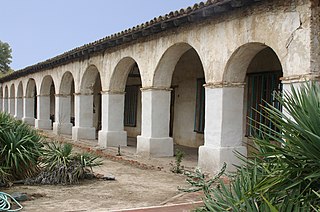
Mission San Miguel Arcángel is a Spanish mission in San Miguel, California. It was established on July 25, 1797 by the Franciscan order, on a site chosen specifically due to the large number of Salinan Indians that inhabited the area, whom the Spanish priests wanted to evangelize.

Mission Santa Inés was a Spanish mission in the present-day city of Solvang, California, and named after St. Agnes of Rome. Founded on September 17, 1804, by Father Estévan Tapís of the Franciscan order, the mission site was chosen as a midway point between Mission Santa Barbara and Mission La Purísima Concepción, and was designed to relieve overcrowding at those two missions and to serve the Indians living north of the Coast Range.

Santa Barbara County, California, officially the County of Santa Barbara, is located in Southern California. As of the 2020 census, the population was 448,229. The county seat is Santa Barbara, and the largest city is Santa Maria.
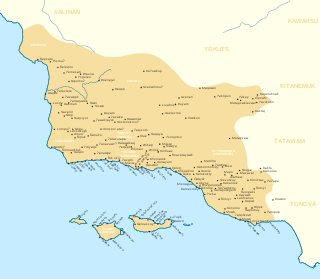
The Chumash are a Native American people of the central and southern coastal regions of California, in portions of what is now San Luis Obispo, Santa Barbara, Ventura and Los Angeles counties, extending from Morro Bay in the north to Malibu in the south. Their territory included three of the Channel Islands: Santa Cruz, Santa Rosa, and San Miguel; the smaller island of Anacapa was likely inhabited seasonally due to the lack of a consistent water source.

Chumashan was a family of languages that were spoken on the southern California coast by Native American Chumash people, from the Coastal plains and valleys of San Luis Obispo to Malibu, neighboring inland and Transverse Ranges valleys and canyons east to bordering the San Joaquin Valley, to three adjacent Channel Islands: San Miguel, Santa Rosa, and Santa Cruz.
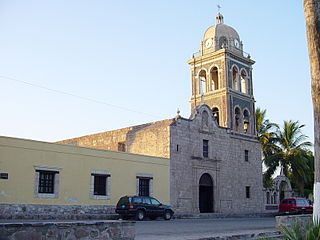
Misión de Nuestra Señora de Loreto Conchó, or Mission Loreto, was founded on October 25, 1697, at the Monqui Native American (Indian) settlement of Conchó in the city of Loreto, Baja California Sur, Mexico. Established by the Catholic Church's Jesuit missionary Juan María de Salvatierra, Loreto was the first successful mission and Spanish town in Baja California.
José Francisco Ortega was an Californio soldier and early settler of Alta California. A member of the Portolá expedition in 1769, Ortega stayed on to become the patriarch of an important Californio family.

The Topatopa Mountains are a mountain range in Ventura County, California, north of Ojai, Santa Paula, and Fillmore. They are part of the Transverse Ranges of Southern California.

SS Mission Buenaventura was a Type T2-SE-A2 tanker built for the United States Maritime Commission during World War II. After the war she was acquired by the United States Navy as USS Mission Buenaventura (AO-111). Later the tanker transferred to the Military Sea Transportation Service as USNS Mission Buenaventura (T-AO-111). The lead ship in her class of fleet oilers, she was named for Mission San Buenaventura located in Ventura, California.
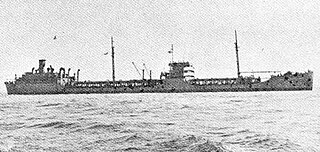
SS Mission Santa Ynez was a Type T2-SE-A2 tanker built for the United States Maritime Commission during World War II. After the war she was acquired by the United States Navy as USS Mission Santa Ynez (AO-134). Later the tanker transferred to the Military Sea Transportation Service as USNS Mission Santa Ynez (T-AO-134). A Mission Buenaventura-class oiler, she was named for Mission Santa Inés located in Solvang, California.
SS Mission Loreto was a Type T2-SE-A2 tanker built for the United States Maritime Commission during World War II. After the war she was acquired by the United States Navy as USS Mission Loreto (AO-116). Later the tanker transferred to the Military Sea Transportation Service as USNS Mission Loreto (T-AO-116). She was a Mission Buenaventura-class oiler and was named for Misión de Nuestra Señora de Loreto Conchó, located in Loreto, Baja California Sur, Mexico, considered the "Head and Mother of all the California Missions."

USNS Mission Santa Ana (T-AO-137) was a Mission Buenaventura-class oiler that served in the United States Navy. The ship was originally intended as USS Concho (AO-102) for the U.S. Navy but her acquisition was canceled. The ship, a Type T2-SE-A3 tanker, was completed as SS Mission Santa Ana and delivered after the end of World War II. The tanker was acquired by the U.S. Navy in 1948 as USS Mission Santa Ana (AO-137), but was transferred to the Military Sea Transport Service upon its creation in 1949. The ship was named for the Santa Ana Estancia, she was the only U.S. Naval Vessel to bear the name.
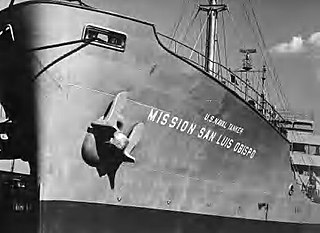
SS Mission San Luis Obispo was a Type T2-SE-A2 tanker built for the United States Maritime Commission during World War II. After the war she was acquired by the United States Navy as USS Mission San Luis Obispo (AO-127). Later the tanker transferred to the Military Sea Transportation Service as USNS Mission San Luis Obispo (T-AO-127). A Mission Buenaventura-class oiler, she was named for Mission San Luís Obispo de Tolosa in San Luis Obispo, California.
SS Mission San Luis Rey was a Type T2-SE-A2 tanker built for the United States Maritime Commission during World War II. After the war she was acquired by the United States Navy as USS Mission San Luis Rey (AO-128). Later the tanker transferred to the Military Sea Transportation Service as USNS Mission San Luis Rey (T-AO-128). She was a Mission Buenaventura-class oiler and was named for Mission San Luis Rey de Francia, located in Oceanside, California.
SS Mission Santa Barbara was a Type T2-SE-A2 tanker built for the United States Maritime Commission during World War II. After the war she was acquired by the United States Navy as USS Mission Santa Barbara (AO-131). Later the tanker transferred to the Military Sea Transportation Service as USNS Mission Santa Barbara (T-AO-131). She was a Mission Buenaventura-class oiler and was named for Mission Santa Barbara in Santa Barbara, California.
SS Mission Santa Clara was a Type T2-SE-A2 tanker built for the United States Maritime Commission during World War II. After the war she was acquired by the United States Navy as USS Mission Santa Clara (AO-132). Later the tanker transferred to the Military Sea Transportation Service as USNS Mission Santa Clara (T-AO-132). She was a Mission Buenaventura-class oiler and was named for Mission Santa Clara de Asís in Santa Clara, California.
SS Mission Santa Cruz was a Type T2-SE-A2 tanker built for the United States Maritime Commission during World War II. After the war she was acquired by the United States Navy as USS Mission Santa Cruz (AO-133). Later she transferred to the Military Sea Transportation Service as USNS Mission Santa Cruz (T-AO-133). She was a member of the Mission Buenaventura class and was named for Mission Santa Cruz in Santa Cruz, California.
Rancho Lomas de la Purificacion was a 13,341-acre (53.99 km2) Mexican land grant in present-day Santa Barbara County, California given in 1844 by Governor Manuel Micheltorena to Agustín Janssens. The name refers to the hills of Mission La Purísima Concepción. The grant extended between the Santa Ynez Mountains and the south bank of the Santa Ynez River opposite Rancho Cañada de los Pinos, and south east of Mission Santa Inés and present day Santa Ynez, in the Santa Ynez Valley.

The Original Mission La Purísima or the Site of the original mission and remaining ruins of La Purisima Mission is a California Historical Landmark in Lompoc, California. The site was the location of the California Mission from its founding on December 8, 1787, by Fermín Lasuén till it was destroyed by the 1812 Ventura earthquake on December 12, 1812. At the site are still a few remains of the old mission. The ruins are located at 541 South F Street, Lompoc, Santa Barbara County, California. The site became a California State Historical Landmark No. 928 on June 29, 1979. La Purisima Mission was moved to a new site three miles away to the northeast. The original mission was associated with the Presidio of Santa Barbara. Fermín Lasuén (1736-1803) was a Spanish Franciscan missionary to Alta California and the president of the Franciscan missions. He was the founder of nine of the twenty-one Spanish missions in California including original Mission La Purísima, the 11th mission.













